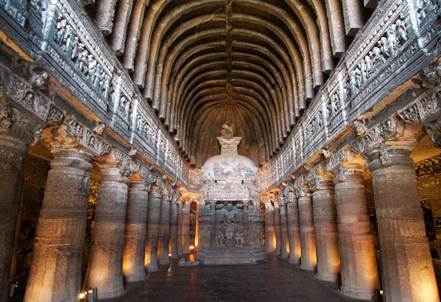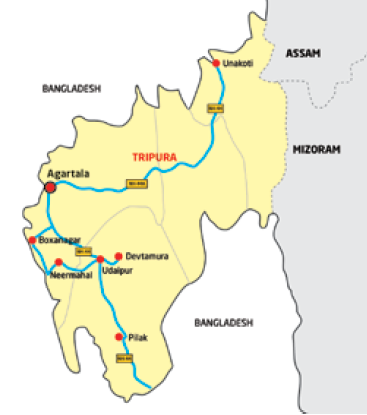Shyamsundar Tila, our first stop, is renowned for the
remains of the excavated base of a massive cruciform Buddhist temple that stood
here sometime around the ninth century. Excavated in 1998-99 by the ASI, the
site revealed some huge sandstone statues of the Maitreya Buddha and other
Bodhisattva images, along with a collection of remarkable terracotta plaques
depicting scenes from the Jatakas as well as those from the Puranas and scenes
from everyday life. The harsh noonday sun couldn’t dampen the thrill I felt standing
amid the remains of an ancient Chaitya Griha. Life, then, must have been much
like this, with little hamlets punctuated with paddy fields and forests. Yet it
felt like stepping into deep time, when trade and ideas were flowing to and
from Bengal, along with Theravada and Mahayana Buddhism. Flourishing under the
vassal states of the Pala Empire, the last big patron of Buddhism in India -
these regions of Tripura supplied learned bhikkus to the universities of
Nalanda and Vikramshila, and priests to Burma.

an ancient Chaitya
Griha
But more interesting were the reports I got from the
caretakers at the sites of ancient statues that had been given away in more
ignorant times to random people who misappropriated their cultural heritage to
their own ends. Just beside the excavated mound of Thakurani Tila which was the
site of an extensive monastery and adjacent to other unexcavated sites, is a
Shiva temple that worshipped a ninth-century Naga statue. More enquiries led us
to the massive, modern Raj Rajeshwari temple in nearby Muhuripur. Inside stood
the statue of a unique fourarmed Durga, a Ganesha and a Surya, all three from
the Pilak site. Even more astonishingly, in the centre was a massive image of
the popular Pala-era Tantric Buddhist goddess Cunda, complete with eighteen
arms. With crudely painted eyes and a garish gold necklace, it is worshipped as
Kali here.
But the final surprise was still the greatest. I had been
hearing about the ashram of a local witch doctor who lived in the village of
Kalma. He had something I wanted to see very badly. So we wandered into the
forest, asking various local Reangs for the ojhabari (house of the witch
doctor). Finally, on the outskirts of Kalma village, we found him, a wizened
old man, grave and calm. Did he have a temple, I asked. He nodded and motioned
to me to follow him. We walked across fields and through a grove of trees to a
rough and ready temple adorned with signs of ‘Jai Ma Kali’ and marked with
tridents. He washed his feet, unlocked the door, and stepped in. Inside stood a
giant apparition. It looked like Kali, wearing a garish red and gold sari. I
looked closer: it had a crown of gold, golden painted eyes and even a painted
red tongue. But it wasn’t Kali. For a start it had rounded masculine shoulders,
the hand mudras were all wrong (Kali never blessed anyone) and it was standing
on a vishwa padma (world lotus) pedestal, a Buddhist motif, and was flanked by
diminutive statues of Tara. Then it dawned on me: here I was, looking at a
1,200-year-old statue of the Avalokiteswara Buddha! Tripura had surprised me
once again.

Candi Mendut is a
1200 year old temple (9th century)
The information
Getting there
Daily hopping flights connect Agartala via Kolkata to Delhi
and Mumbai. For other cities, change flights in Kolkata. The one way fare from Delhi
is around 5,500.
Getting around
Tripura has good roads and the best way to get around is to
rent a car with a driver. There are many options but you can contact Asit
Bhowmik (9836180038) of Point to Point Tours and Travels. Rates: 7/km; car
charges 600 per day, driver charges 100 per day.

The information
Tripura
Where to stay
Tripura has a good network of state tourism guesthouses.
Apart from Agartala, the other hubs are Kailashahar for North Tripura, Udaipur
for South Tripura and Melaghar for West Tripura (all from 500 on twin-sharing
basis; 01381-2325930, tripuratourism.nic.in).
What to see & do

the Ujjayanta
Palace
Despite being a fairly small state, there’s much to see and
do in Tripura. Agartala offers the Ujjayanta Palace (entry 5), the stunning
home of the erstwhile kings of Tripura. It is currently being renovated but
even a ramble in its grounds is worth it. Also visit the Benuban Vihara, a
modern Buddhist temple, and the Chaturdash Devta Mandir in old Agartala. A
visit to the State Museum (entry 2) is also worthwhile. 30km from Agartala lies
the Kamala Sagar Lake beside the Bangladesh border, which is worth a visit for
the Kashba Kali temple.
The ruins of the Buddhist stupa at Boxanagar lie 40km southeast
of Agartala via Bishalgarh. In North Tripura, visit Unakoti, 180km from
Agartala via Kailashahar. The forest gate at Baramura on NH-44, about 30km from
Agartala opens daily at 8am for vehicular traffic.
The old capital of Udaipur lies 55km south of Agartala.
Apart from the Tripurasundari temple, other sights include the Mahadev Bari and
Gunabati group of temples next to Mahadev lake and Bhuvaneshwari temple and the
ruins of the old palace across the river.
The rock-cut murals of Devtamura lie 30km east of Udaipur.
Drive to Chabimura village near the town of Amarpur to arrange for a boat to
take you down the river for around 500.
Pilak’s Buddhist ruins are 60km south of Udaipur near the
town of Jolaibari. The ruins are situated along three sites, and all three are
well marked. The lake palace of Neermahal is situated 22km west of Udaipur near
Melaghar. Ferry charges across the lake are 20 per head. Entry fee 10.